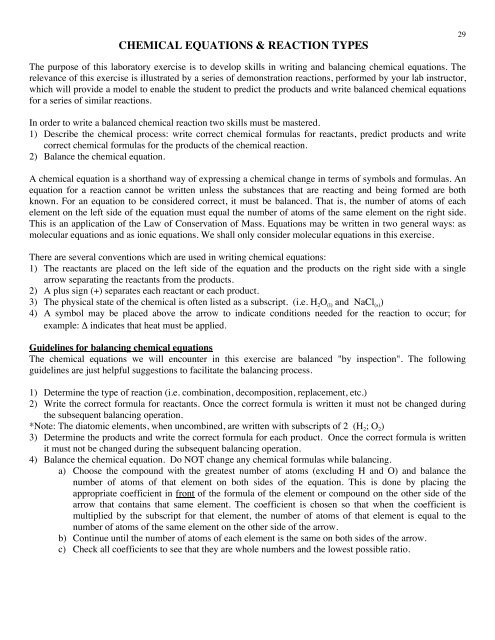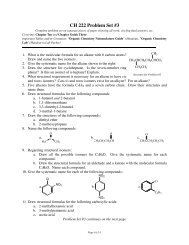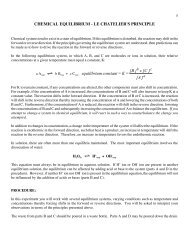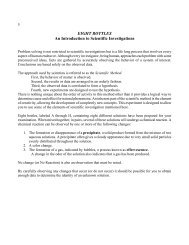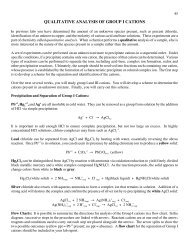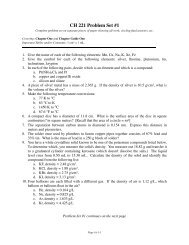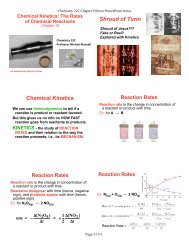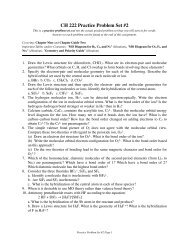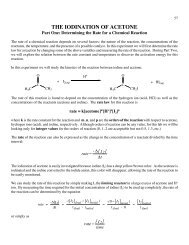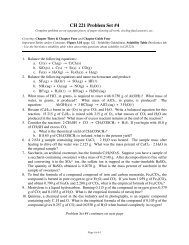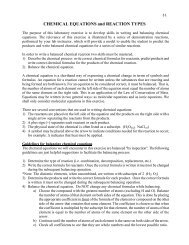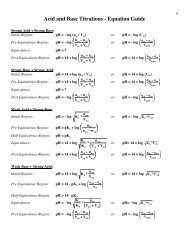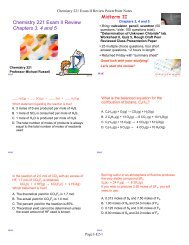Chemical Equations & Reactions
Chemical Equations & Reactions
Chemical Equations & Reactions
You also want an ePaper? Increase the reach of your titles
YUMPU automatically turns print PDFs into web optimized ePapers that Google loves.
CHEMICAL EQUATIONS & REACTION TYPES<br />
The purpose of this laboratory exercise is to develop skills in writing and balancing chemical equations. The<br />
relevance of this exercise is illustrated by a series of demonstration reactions, performed by your lab instructor,<br />
which will provide a model to enable the student to predict the products and write balanced chemical equations<br />
for a series of similar reactions.<br />
In order to write a balanced chemical reaction two skills must be mastered.<br />
1) Describe the chemical process: write correct chemical formulas for reactants, predict products and write<br />
correct chemical formulas for the products of the chemical reaction.<br />
2) Balance the chemical equation.<br />
A chemical equation is a shorthand way of expressing a chemical change in terms of symbols and formulas. An<br />
equation for a reaction cannot be written unless the substances that are reacting and being formed are both<br />
known. For an equation to be considered correct, it must be balanced. That is, the number of atoms of each<br />
element on the left side of the equation must equal the number of atoms of the same element on the right side.<br />
This is an application of the Law of Conservation of Mass. <strong>Equations</strong> may be written in two general ways: as<br />
molecular equations and as ionic equations. We shall only consider molecular equations in this exercise.<br />
There are several conventions which are used in writing chemical equations:<br />
1) The reactants are placed on the left side of the equation and the products on the right side with a single<br />
arrow separating the reactants from the products.<br />
2) A plus sign (+) separates each reactant or each product.<br />
3) The physical state of the chemical is often listed as a subscript. (i.e. H 2O (l) and NaCl (s))<br />
4) A symbol may be placed above the arrow to indicate conditions needed for the reaction to occur; for<br />
example: Δ indicates that heat must be applied.<br />
Guidelines for balancing chemical equations<br />
The chemical equations we will encounter in this exercise are balanced "by inspection". The following<br />
guidelines are just helpful suggestions to facilitate the balancing process.<br />
1) Determine the type of reaction (i.e. combination, decomposition, replacement, etc.)<br />
2) Write the correct formula for reactants. Once the correct formula is written it must not be changed during<br />
the subsequent balancing operation.<br />
*Note: The diatomic elements, when uncombined, are written with subscripts of 2 (H 2; O 2)<br />
3) Determine the products and write the correct formula for each product. Once the correct formula is written<br />
it must not be changed during the subsequent balancing operation.<br />
4) Balance the chemical equation. Do NOT change any chemical formulas while balancing.<br />
a) Choose the compound with the greatest number of atoms (excluding H and O) and balance the<br />
number of atoms of that element on both sides of the equation. This is done by placing the<br />
appropriate coefficient in front of the formula of the element or compound on the other side of the<br />
arrow that contains that same element. The coefficient is chosen so that when the coefficient is<br />
multiplied by the subscript for that element, the number of atoms of that element is equal to the<br />
number of atoms of the same element on the other side of the arrow.<br />
b) Continue until the number of atoms of each element is the same on both sides of the arrow.<br />
c) Check all coefficients to see that they are whole numbers and the lowest possible ratio.<br />
29
30<br />
The following example illustrates these guidelines.<br />
Ca(OH) 2 + H 3PO 4 ==> Ca 3(PO 4) 2 + H 2O<br />
Start by balancing the calcium atoms in calcium phosphate first, since calcium phosphate contains the most<br />
atoms of an element other than H or O. This requires a coefficient of 3 to be placed in front of Ca(OH) 2 on the<br />
other side of the arrow.<br />
3 Ca(OH) 2 + H 3PO 4 ==> Ca 3(PO 4) 2 + H 2O<br />
Next balance the phosphate (if a polyatomic is found on both sides of the equation, it is easier to balance for the<br />
polyatomic than as each type of element) by putting a 2 in front of H 3PO 4.<br />
3 Ca(OH) 2 + 2 H 3PO 4 Ca 3(PO 4) 2 + H 2O<br />
The hydrogen atoms now total 12 on the left side, 6 from the 3 Ca(OH) 2 "molecules" and 6 from 2 H 3PO 4<br />
molecules. Therefore, place a 6 in front of the formula for water and the equation will be balanced.<br />
3 Ca(OH) 2 + 2 H 3PO 4 Ca 3(PO 4) 2 + 6H 2O<br />
All coefficients are whole numbers and the lowest possible ratio.<br />
Categories of <strong>Chemical</strong> <strong>Reactions</strong>:<br />
Most chemical reactions can be grouped into one of four categories:<br />
1) Combination reactions A + B → AB<br />
2) Decomposition reactions AB → A + B<br />
3) Single replacement reactions A + BC → AC + B<br />
(Metal replace metals; non-metals replace non-metals.)<br />
4) Double displacement reactions AB + CD → AD + CB<br />
a) Precipitation (solid forms)<br />
b) Neutralization (water is formed) [also called acid/base]<br />
Knowledge of the kind of reaction is useful in predicting the products in a particular reaction. Your instructor<br />
will demonstrate several reactions of each category, predicting the products, writing and balancing the chemical<br />
equation in each case. Using these as models, you will write and balance chemical equations of similar<br />
reactions.
CHEMICAL EQUATIONS Name:<br />
Write balanced chemical equations for each reaction below.<br />
A. COMBINATION:<br />
1) Magnesium metal burning in air.<br />
2) The reaction of iron with oxygen to yield iron(III) oxide.<br />
3) The reaction of sodium metal with chlorine gas.<br />
4) The reaction of calcium with fluorine gas.<br />
5) The reaction of ammonia (NH 3) with hydrogen chloride to yield ammonium chloride.<br />
31
32<br />
B. DECOMPOSITION:<br />
1) The decomposition of ammonium dichromate, (NH 4) 2Cr 2O 7, into nitrogen, water, and chromium(III) oxide.<br />
2) The decomposition of nitrogen triiodide into its elements.<br />
3) The decomposition of potassium chlorate to potassium chloride and oxygen.<br />
4) The thermal decomposition of ammonium carbonate into ammonia, carbon dioxide and water<br />
5) The decomposition of lead(IV) oxide into its elements.
C. SINGLE REPLACEMENT:<br />
1) The reaction of a solution of silver(I) nitrate with copper metal (copper(II) nitrate is a product).<br />
2) The reaction of sodium metal with water to create hydrogen gas and sodium hydroxide.<br />
3) Zinc metal with sulfuric acid (zinc(II) sulfate is a product).<br />
4) Chlorine with aqueous sodium bromide.<br />
5) Aluminum metal with aqueous copper (II) sulfate.<br />
33
34<br />
D. DOUBLE DISPLACEMENT:<br />
1) The reaction of aqueous solution of calcium chloride with ammonium carbonate.<br />
2) The action of vinegar (dilute acetic acid) on sodium bicarbonate.<br />
3) The reaction of hydrogen sulfide on a solution of lead(II) nitrate.<br />
4) The reaction of solutions of sodium chloride with silver(I) nitrate.<br />
5) The reaction of magnesium chloride with sulfuric acid.<br />
POSTLAB QUESTIONS: Write balanced equations and classify.<br />
1. Calcium reacts with chlorine<br />
2. Sodium chloride is mixed with lead(II) nitrate<br />
3. Sodium reacts with zinc(II) sulfate<br />
4. Diphosphorus pentoxide breaks down into its elements.<br />
5. Metallic aluminum reacts with nickel(II) nitrate


